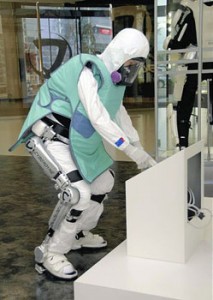Cyberdyne, Inc. is offering to help
The Japanese government is searching for new ways to clean up the mess created by the reactor meltdowns earlier this year at the Fukushima Daiichi nuclear plant. As lawmakers and officials study new energy policy options, which they plan to present by next spring, a company called Cyberdyne, Inc. is offering to help with the more immediate concern of removing radioactive debris in and around the reactors with the help of a robotic exoskeleton.
Yoshiyuki Sankai, a professor of system and information engineering at Japan’s University of Tsukuba, first conceived of Cyberdyne’s sleek, white Hybrid Assistive Limb (HAL) exoskeleton in 1997 as a way to augment the body’s own strength or do the work of ailing (or missing) limbs. Now he is offering his company’s Iron Man-like suit for Fukushima clean-up workers. They would wear the exoskeletons under their tungsten anti-radiation outfits, which weigh 15 kilograms—by comparison, most people wear one or two kilograms of street clothing. The thinking is that the suits, which can support up to 60 kilograms of protective material, would allow workers to take longer shifts and clean up the site faster.
Using a sensor attached to the wearer’s skin, the exoskeleton detects brain signals sent to muscles. The exoskeleton’s computer analyzes these signals to determine how it must move (and with how much force) to assist the wearer. At this point, the battery-powered suit can operate for about an hour and a half with a full charge to its lithium-ion 100-volt AC battery.
Cyberdyne (which film buffs will recognize as the name of the company that built the ill-fated “Skynet” in the Terminator movies) first demonstrated the HAL in 2005. By April 2008 the company had created a prototype of the exoskeleton standing 1.6 meters tall. In 2009 Cyberdyne began mass producing the suits—which cost $14,000 to $19,000—for disabled people. They are now used in more than 100 hospitals and welfare centers throughout Japan, according to The Tokyo Times.
Read more . . .
Bookmark this page for “Robotic Exoskeleton” and check back regularly as these articles update on a very frequent basis. The view is set to “news”. Try clicking on “video” and “2” for more articles.








